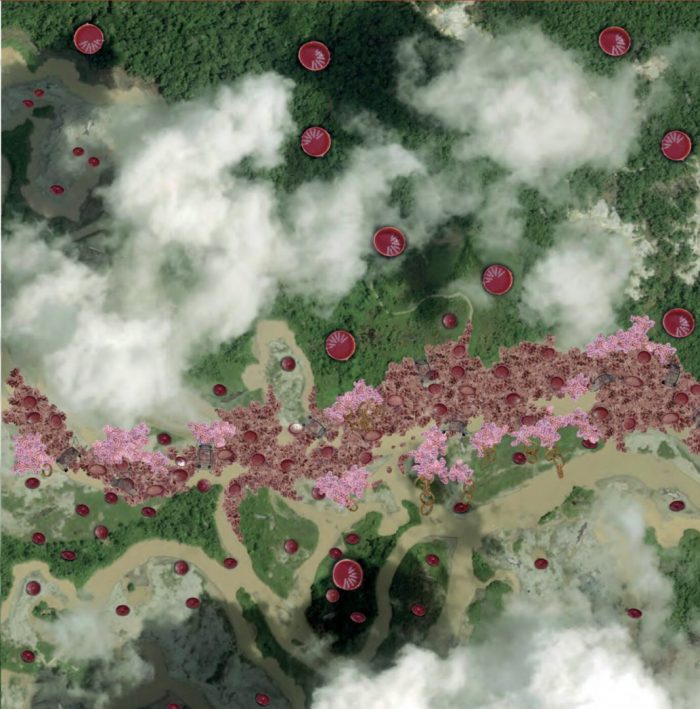Atrato Collaboration: Mercury Bodies
Atrato Collaborations : Mercury Bodies
About Atrato Collaborations
Atrato Collaborations (2018 – 2020) facilitated exchanges between cultural managers and artists from Colombia, Switzerland and Germany. In Colombia it was aimed specifically at participants from Quibdó, Chocó, whose practice related to the Atrato River as a ‘subject of biocultural rights’. Participants from Switzerland and Germany were interested in the idea of collaborations between practices and contexts that are far apart but could meet -improbably- to generate alliances that inspire each other and seek common actions.
#AtratoCollaborations – A project by Más Arte Más Acción in the framework of the programme “COINCIDENCIA” cultural exchanges Switzerland – South America of the Swiss Foundation for Culture Pro Helvetia.
#Coincidence_Prohelvetia #Coincidence_Colombia
Mercury Bodies written by Carmenza Rojas:
Knowbotiq proposed a fictional device, a kind of fictional planetary assembly, which houses human, non-human and fictional bodies such as mercury bodies, water bodies, gold bodies. The members of the assembly, artists, collectives situated in diverse positions on the planet, will develop aesthetic, performative forms and materialities in response to the current land grabbing and exploitations of material, intellectual and spiritual resources in the Atrato River in Afro-Colombia. The fictitious assembly on mercury bodies is an invitation by knowbotiq to artists and art collectives in Quibdó, the feminist collective Fundación Mareia in Bogotá and the arts organisation Más Arte Más Acción to think, study and act together. Bringing together different artistic and educational art practices, this fictitious assembly does not yet pretend to be a linear form of collaboration. It tends to embody various earthly experiments, situated at a distance, with imaginations of fictitious mercurial bodies, with concepts of cosmopolitical encounters (I. Stengers) and with the sharing of divergent knowledge.
Let us imagine that the mercury molecules that contaminate illegal gold mining in the Colombian Atrato River are present on a planetary level: in the apparently clear water reservoirs of Switzerland, in German coal-fired power plants, in the brains of beluga whales as they pass through the oceans, in your used batteries every day, or in the waking Arctic permafrost. These are the same mercury molecules that international traders have been delivering for 30 years through dubious supply chains deep inside Colombian rainforests.
Mercury molecules pollute and harm. The poisoned Atrato River can no longer fulfil its local mission as a food donor, as a means of transport, as a spiritual soul, protecting biodiversity, health and the socio-cultural fabric. The contamination of the Atrato River is multiple and dispersed. It does not only occur in the proximity of the physical flow. Mercury molecules are diffused, travel with the flow of the wind, as raindrops, are mediated as data or affect bodies with concern.
Furthermore, Remote Sensations -Mercury bodies was created; a remote sensing cartography from satellite maps of the Quito River, heavily violated and polluted by illegal gold mining, which involved questions such as; What would it mean to look at satellite images of a stretch of the Atrato River in Afro-Colombia with the sensitivity and affectations of multiple bodies of mercury to reveal what they cannot represent? Would it be possible to undertake a kind of contamination of cartography through aesthetic ornamentation, a reverse forensics, so to speak? Is it possible to approach such artistic strategies with such planetary non-computations? What does it mean to offer the technological unconscious a space within a work such as this?

Elements: 3D models of a female breast, of sewage treatment plants, of a temporary metal bridge, of human bronchial tubes,
of gold jewelry, of the fish Bocachico in the Atrato River, Gold Mercury Amalgams, Dental Amalgams
This way of intervening the external gaze given by the maps allowed new questions and collaborations to be generated. One of them was to turn these writings into a book, and together with Mareia they developed the dance video “Oro” directed by Paula Orozco. In it Loretta Meneses and Danilo Casama, together with the Guardianes del Atrato, established conversations between criticism, fiction about the spirit of gold and criticism of extractivism.
Another space created to close the process was an exhibition presented in Zurich on 10 February 2022. We had a final meeting with Yvonne and Christian, where we agreed to close the relationship within the framework of the project. However, the collaboration and the meeting will continue in a kind of virtual Café, where we will continue the analysis and discussions about Mercury Bodies as a concept of analysis and creation or other concepts that are worked on in the collective, based on intimate conversations and in confidence.
As the last activity of the collaboration between Mareia, MAMA, Independent Artists and Knowbotiq, a sound piece was developed for the exhibition in Zurich by Knowbotiq and other artists on Gold. A SF stage about deep molecular access called: “Remote Evocations”. It was a space of resonance and remote encounters in relation to the effects of the contaminated mercury of the Atrato River in Afro-Colombia. Poems, texts, interview fragments, conversations, compositions, music and memories intertwine with fiction and Afro-utopian perspectives.
To listen to the audios and learn more about the project, visit: https://archive.knowbotiq.net/remote-sensations
